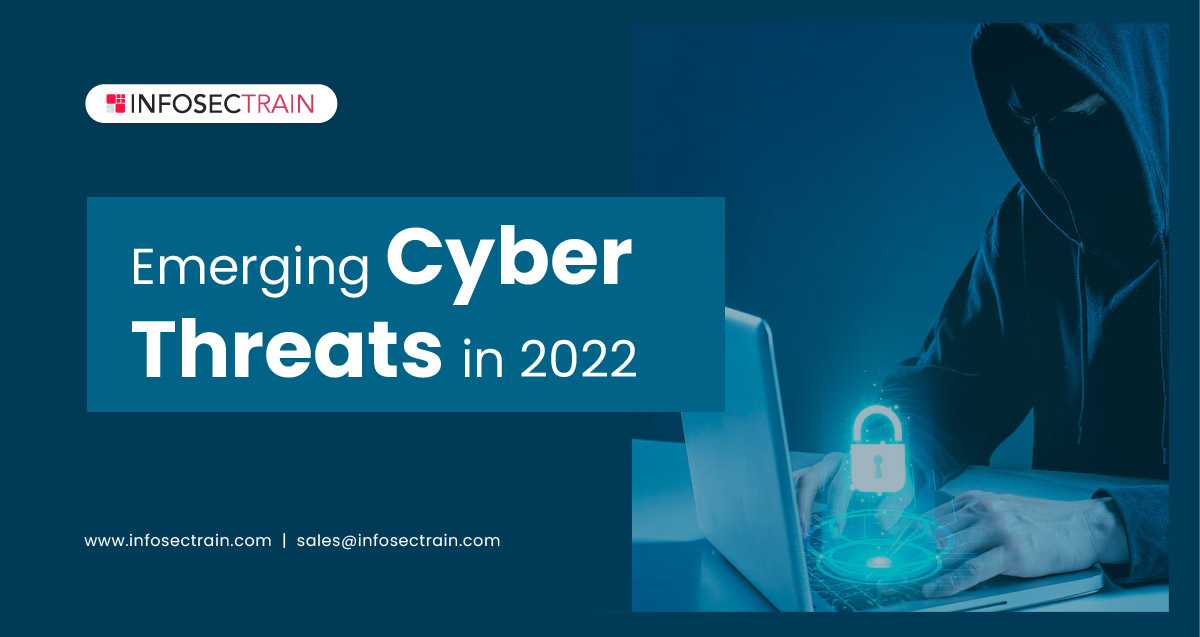Emerging Cyber Threats in 2022
Cybersecurity has long been a top priority, and it will continue to be so as our personal and professional lives become increasingly reliant on digital technologies. This overreliance on digital technologies has overloaded the world with the sophistication and impact of new cybersecurity threats.

The coronavirus pandemic has also played a prominent role in practically every part of our personal and professional lives in recent years. The majority of us work from home. In the wake of the coronavirus pandemic, the cyber threat landscape has also shifted substantially. The use of new and inventive approaches by threat actors in exploiting vulnerabilities and security gaps has escalated the cybersecurity threat.
So in this article, let us discuss the emerging cybersecurity threats in 2022.
1.Social Engineering Attacks: Social engineering is one of the most dangerous and common hacking techniques used by cybercriminals because it relies on human error rather than technical vulnerabilities. This makes these attacks even more dangerous because fooling a human is far easier than hacking a security system.
Social engineering attacks like phishing and email impersonation are projected to continue to evolve in 2022, incorporating new trends, technology, and methods.
2. Ransomware attacks: Cybercriminals frequently use ransomware as a means of extortion. Although they are not new to the cyberworld, they have evolved through time to become more sophisticated, widely available, and convenient for hackers, as well as much more expensive. Ransomware attacks have the potential to wipe out entire businesses.
Cybercriminals can now subscribe to Ransomware-as-a-Service providers, which allow them to use pre-developed ransomware tools to carry out attacks in exchange for a portion of all successful ransom payments. Because of the rise of RaaS, ransomware attacks are now substantially more economical and innovative for even small-time cyber criminals, which results in an increase in the frequency of ransomware attacks.
3. Cloud Vulnerabilities: Businesses are rapidly migrating their operations to the cloud. Cloud technologies are also evolving as a result of this. However, we expect that as the cloud becomes more popular, it will grow more secure, but the opposite is true. With the rise in popularity, the cloud is increasingly exposed to security attacks. Data loss, data breaches, system crashes, hostile assaults on cloud infrastructure, privacy concerns, and data ownership rights are possible outcomes. This indicates that the threat of cloud security breaches is unlikely to decrease in 2022.
The widespread usage of cloud technology has resulted in numerous security flaws in deployments. Cloud attacks often take advantage of weak setups and security policies in these implementations. Even when security technologies are stacked over cloud-based assets, fraudsters can exploit them. Furthermore, most firms use hybrid cloud architectures to run their workloads, exposing them to even more threats.
4. Mobile Device Vulnerabilities: The use of mobile devices in our personal and professional life has increased in recent years, and this trend will continue in 2022 and subsequent years. As a result, cybercriminals have turned their attention to mobile devices. The rise in remote work has increased mobile device vulnerabilities, leading to an increase in firms embracing Bring-Your-Own-Device (BYOD) rules. In order to enable malware transmission, cybercriminals are also targeting widespread usage of mobile wallets and touchless payment technology.
5. Misconfiguration issues: With the advancement of digital technologies, the frequency of negligent software and system configuration errors made by ordinary users or professionals at work has increased, providing more exploitable possibilities for cybercriminals. Even competent security systems are likely to include at least one flaw in the software installation and configuration.
6. Internet of Things (IoT) Vulnerabilities: Smart devices have become more prevalent in personal and professional lives as the globe becomes more linked. IoT connectivity exposes hackers worldwide to new vulnerabilities, increasing the possibility of IoT devices being attacked by cybercriminals. According to researchers, the use of IoT devices will grow in 2022 and beyond, resulting in an even more extensive network of access points that can be exploited to attack personal and corporate networks.
7. Poor Cybersecurity Practices: Cybersecurity practices may include the use of firewalls, multi-factor authentication methods, VPNs, and more. However, most users engage in bad cybersecurity habits, such as using weak passwords, using the same password for many accounts, or writing it down anywhere, which can lead to data breaches, assaults, and unwanted access. If firms and people do not enhance their cyber policies, this will be observed more in 2022, resulting in more danger than before.
TRAINING CALENDAR of Upcoming Batches For Threat Hunting
| Start Date | End Date | Start - End Time | Batch Type | Training Mode | Batch Status | |
|---|---|---|---|---|---|---|
| 27-Apr-2024 | 02-Jun-2024 | 19:00 - 23:00 IST | Weekend | Online | [ Open ] |
Final Words:
Scammers, hackers, and fraudsters have had more possibilities to strike as more of our lives have migrated online. With the rise of cyber threats around the world, we must all evolve our defenses. You can enroll in InfosecTrain‘s numerous cybersecurity and cloud security training courses to learn from professionals how to defend your digital landscape from rising cyber threats.
We are the world’s leading provider of cybersecurity training and consulting services. We recommend that you enroll in our CompTIA Security+ certification training course if you are new to the field of cybersecurity. You can also enroll in our Cybersecurity Orientation Program, which is an introductory course created explicitly for someone who is entirely new to the field.





 1800-843-7890 (India)
1800-843-7890 (India) 
